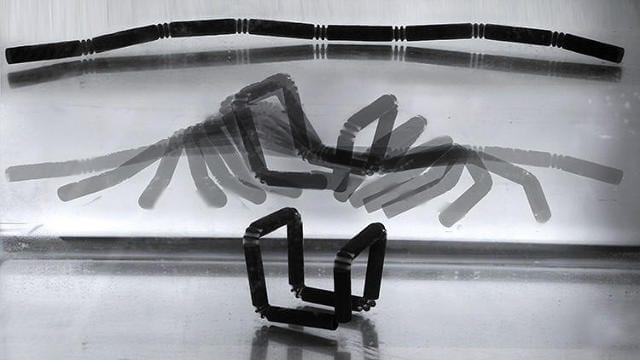
LUT is developing an entirely new kind of welding system, one which solves quality and productivity problems related to automated and mechanised welding.
The system is self-adjusting, flexible and adaptable, such that it can be integrated as part of different robotic systems and different manufacturers’ power supplies.
It’s self-adjusting properties are based on a new kind of sensor system which is controlled by a neural network program. Most often in welding a monitoring sensor is used which tracks the bevel angle, an essential part of the welding process. In the system being developed by LUT, there are also monitoring sensors for the thermal profile (the weld pool’s heat values) and the weld form. The monitoring data is transferred from the sensors to the neural network, which is able to deduce and react to simultaneous changes in multiple variables.
‘When a mistake is detected, the system is able both to correct it during the welding process and also calculate what other faults may arise. Thus the final product is flawless. The problem with welding automation systems is that certain values are set for the work, based on which the whole weld is carried out, and only then is it checked whether the result is good. Now the welding is monitored throughout the whole process’, explains Project Manager Markku Pirinen.
In the gas-shielded arc welding process, factors affecting outcome quality include the welding current, the arc voltage, the wire feeding and transporting speeds, and the position of the welding gun. With the help of the neural network, a regulating window can be set for these system variables, and they can then be controlled so that they remain within certain limits, which ensures that final product is as required.
‘In practice this means that when the welding values approach the boundary values set in the parameter window, the system corrects the process so that the welding values move back towards the centre of the value range and the possible defect is prevented.’
Added value for Arctic steel construction
The new system works very well with high-strength steel welding, as the parameter windows for the high-strength materials are significantly narrower than those for construction steel, and the harder the steel is, the more difficult it is to weld. High-strength steel is used, for example, in arctic steel construction work, where the materials used must be light, robust, and strong.
‘In the Arctic, welds must be of higher quality than in warmer regions. In the North, errors would have catastrophic consequences. For example, the welds must be able to withstand temperature of up to -60 °C, and they must be flawless. Operating safety must be so high that no accidents occur at all’, says Pirinen.
Read more: The welding system of the future is self-learning
The Latest on: Self-learning robots
[google_news title=”” keyword=”Self-learning robots” num_posts=”10″ blurb_length=”0″ show_thumb=”left”]
via Google News
The Latest on: Self-learning robots
- Exclusive: Wayve co-founder Alex Kendall on the autonomous future for cars and robotson May 8, 2024 at 11:01 am
U.K.-based autonomous vehicle startup Wayve started life as a software platform loaded into a tiny electric "car" called Renault Twizy. Festooned with ...
- The cheapest robot vacuum sales and deals for May 2024on May 7, 2024 at 5:00 pm
The Roomba also features smart mapping so the vacuum will learn what rooms ... i7's more expensive mapping and self-cleaning features. There are also some excellent robot vacuum sales on the ...
- ChatGPT trains robot dog to walk on Swiss ballon May 6, 2024 at 7:50 pm
This quadruped wobbling along balanced on top of a yoga ball is a fun experiment to watch – but at its core, it demonstrates that AIs like GPT-4 can train robots to perform complex, real-world tasks ...
- MaxDiff RL Algorithm Improves Robotic Learning with “Designed Randomness”on May 6, 2024 at 1:58 pm
In a groundbreaking development, engineers at Northwestern University have created a new AI algorithm that promises to transform the field of smart robotics. The algorithm, named Maximum Diffusion ...
- Forest walker robot takes a brutal beating and keeps marchingon May 5, 2024 at 5:25 pm
Somebody better break it to the Ewoks: crafty log tricks aren't gonna cut the mustard. LimX Dynamics has released video of its P1 Biped – heavily inspired by the AT-ST walker from Star Wars: Return of ...
- How Alphadroid Is Reinventing The Indian Hospitality Space With Its Autonomous Roboton May 3, 2024 at 9:30 pm
Founded in 2023 by Sanjeev Kumar and incubated at IIIT Lucknow, Alphadroid provides service robots for all categories of restaurants ...
- Swaayatt Robots: Is This Autonomous Driving Startup Just Hype Or The Future Of Vehicles?on May 2, 2024 at 8:25 pm
Bhopal-based Swaayatt Robots has built proprietary algorithms and claims to have unparalleled capabilities in Level 5 autonomous driving ...
- Random robots are more reliableon May 2, 2024 at 10:54 am
New algorithm encourages robots to move more randomly to collect more diverse data for learning. In tests, robots started with no knowledge and then learned and correctly performed tasks within a ...
- FDA-approved surgical robots trend toward autonomy, study findson April 29, 2024 at 6:24 pm
A systematic review in npj Digital Medicine categorizes FDA-approved surgical robots by their levels of autonomy, highlighting a need for standardized definitions and greater regulatory clarity as ...
- Robots vs. Animals: Who Wins the Race in Natural Settings?on April 29, 2024 at 2:08 pm
Summary: Researchers explored whether modern robots can outpace biological organisms in speed and agility. The study concludes that despite advances in engineering, animals still surpass robots in ...
via Bing News










